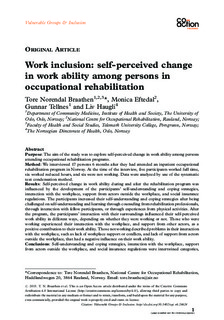Work inclusion: self-perceived change in work ability among persons in occupational rehabilitation
Journal article, Peer reviewed
Published version
Permanent lenke
http://hdl.handle.net/11250/2437772Utgivelsesdato
2015-03-27Metadata
Vis full innførselSamlinger
Originalversjon
Braathen, T.N., Eftedal, M. & Tellnes, G. Work inclusion: self-perceived change in work ability among persons in occupational rehabilitation. Vulnerable Groups & Inclusion 6 (2015) http://dx.doi.org/10.3402/vgi.v6.26624Sammendrag
Purpose: The aim of the study was to explore self-perceived change in work ability among persons attending occupational rehabilitation programs. Method: We interviewed 17 persons 6 months after they had attended an inpatient occupational rehabilitation program in Norway. At the time of the interview, five participants worked full time, six worked reduced hours, and six were not working. Data were analyzed by use of the systematic text condensation method. Results: Self-perceived change in work ability during and after the rehabilitation program was influenced by the development of the participants’ self-understanding and coping strategies, interaction with the workplace, support from actors outside the workplace, and social insurance regulations. The participants increased their self-understanding and coping strategies after being challenged on self-understanding and learning through counseling from rehabilitation professionals, through interaction with fellow participants, or through experiences from physical activities. After the program, the participants’ interaction with their surroundings influenced their self-perceived work ability in different ways, depending on whether they were working or not. Those who were working experienced their interaction with the workplace, and support from other actors, as a positive contribution to their work ability. Those not working described problems in their interaction with the workplace, such as lack of workplace support or conflicts, and lack of support from actors outside the workplace, that had a negative influence on their work ability. Conclusions: Self-understanding and coping strategies, interaction with the workplace, support from actors outside the workplace, and social insurance regulations were intertwined categories, influencing each other and consequently the participants’ self-perceived work ability during and after occupational rehabilitation.

